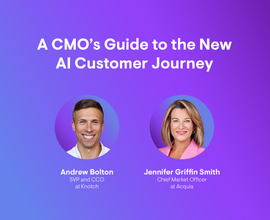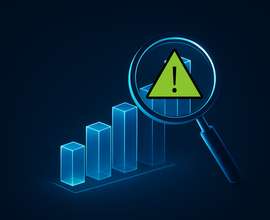The 2026 AEO / GEO Benchmarks Report
As AI search becomes a critical new brand visibility channel, this report establishes the first definitive benchmarks for AEO (answer engine optimization).
We analyzed 10 key industries to measure AI referral traffic, AI search market share, and performance in Google’s AI Overviews featuring exclusive insights from Seth Besmertnik, CEO of Conductor, and Pat Reinhart, VP, Services and Thought Leadership at Conductor, so you can benchmark your strategy against new AEO / GEO KPIs and top brands in your industry.
The main takeaway: AI isn’t replacing search—it’s replacing your website as the first place customers engage with your brand. It’s created a parallel surface of visibility that determines which brands are seen inside AI answers before a user ever clicks. Understanding and optimizing for this new surface is the next frontier of digital visibility.
Executive summary
Website traffic comes from multiple channels, including organic search, direct, paid, referral, and social. For years, organic search has been the undisputed cornerstone of sustainable growth. Unlike paid campaigns, an effective, optimized piece of content could drive reliable, long-term traffic, revenue, and conversions for years.
But now there’s a new search experience for brands to prioritize: AI answer engines.
The rise of AI answer engines and Google’s integration of AI Overview (AIO) results directly onto traditional SERPs means users are increasingly getting answers from AI-generated summaries directly rather than clicking a link, leading to a surge in zero-click searches.
While organic search still fuels the majority of discovery, AI has introduced what we call a parallel surface of visibility—an invisible layer that determines which brands are seen before anyone clicks. Visibility no longer begins on your website; it starts within the AI experiences that answer questions, guide intent, and shape perception in real time.
In this new model, brand discovery happens long before a user lands on your site. If your brand isn’t cited, mentioned, or referenced in these AI answers, it’s effectively absent from the modern customer journey. That means AI visibility is becoming a critical new currency for not only AEO and GEO success, but also long-term digital success.
It’s a seismic shift and poses a new challenge to digital leaders and marketers: how to benchmark search success and measure share of voice on AI search surfaces, especially when content doesn’t necessarily generate clicks.
People keep worrying about AI killing traditional organic practices, but that’s the wrong way to think about it.
We’re living in a hybrid, two-channel world where the traditional organic experience is being enhanced by AI, and a completely new channel is emerging that should be viewed as one of the greatest opportunities of our generation. Brands need to adapt their strategies to optimize for both channels, not one or the other.
The data shows that AI referral traffic currently represents just over 1% of total web visits and is growing by roughly 1% each month, on average. It will never rival traditional organic search traffic—but that’s not the point. AI visibility is becoming its own performance channel, one that signals which brands are trusted enough to enter the answer. Winning in this space isn’t about clicks; it’s about credibility.
For 2026, the question isn’t how to grow AI referral traffic; it’s how to grow brand visibility inside AI experiences. Referral traffic data is simply a signal of where discovery is shifting, not the goal itself.
That’s where Conductor comes in.
As the only end-to-end, enterprise AEO platform built on the industry's most complete data engine, Conductor is uniquely positioned to help brands navigate this new era of discovery. We took on the challenge of identifying new industry-specific benchmarks to inform your 2026 strategy in an AI-first world.
The following research provides the first layer of industry-specific benchmark data essential for understanding and driving success in the AI search landscape. It moves beyond traditional website analytics to provide key context for evaluating your brand’s total search performance and relevance by identifying the latest benchmarks for AI search, AI Overviews, and organic traffic to help leaders adapt existing strategies to ensure brands dominate the modern customer journey.
Top takeaways
In our analysis, we uncovered several key benchmarks to help digital leaders assess their AI search, AEO/GEO, and AIO performance, specifically:
- AEO, GEO, & AI search insights:
- AI referral traffic accounts for 1.08% of all website traffic for these 10 key industries.
- The IT (2.8%) and Consumer Staples (1.9%) industries had the highest percentage of their total traffic coming from AI referrals.
- On average, AI referral traffic is growing around 1% month-over-month.
- ChatGPT dominates: On average, 87.4% of all AI referral traffic across these 10 industries comes from ChatGPT.
- Unsurprisingly, domains like Amazon (17.99%) and Google (5.34%) received the most citations in the Consumer Staples and IT industries, respectively.
- In the Financials industry, publishers like NerdWallet (6.73%) are winning more AI citations than traditional banks.
- Zillow dominates Real Estate brand mentions with 7.36% of AI market share, despite not being a top 5 cited domain.
- AI referral traffic accounts for 1.08% of all website traffic for these 10 key industries.
- AIO insights:
- Of the 21.9M Google searches we analyzed, 5.5M generated an AIO result (25.11%).
- Just over one quarter of the analyzed Google searches triggered an AIO result.
- The Health Care industry receives the highest amount of AIO results (48.75%), followed by the Financials (25.79%) and Utilities (25.4%) industries.
- The industries with the lowest percentage of AIO results are Real Estate (4.48%) and Consumer Staples (6.82%).
- Of the 21.9M Google searches we analyzed, 5.5M generated an AIO result (25.11%).
What this data means for the future of search
The rise of AI discovery is reshaping how visibility works and rewriting the customer journey, surfacing brand answers rather than search results.
This shift doesn’t mark the decline of SEO, but its expansion. AI search functions as a parallel surface of visibility—a new arena where brand credibility is measured by citations, mentions, and inclusion within AI-generated responses.
For digital leaders, that means success in 2026 won’t be defined solely by organic traffic or rankingsRankings
Rankings in SEO refers to a website’s position in the search engine results page.
Learn more. It will hinge on how effectively a brand appears inside AI answers, AI Overviews, and LLM-powered recommendations. These results indicate that, while AI search is still in its infancy, its impact on brand discovery is already substantial.
AI hasn’t replaced search—it’s replaced your website as the first touchpoint. The brands showing up in AI answers today are shaping the new customer journey.
To win on this new surface, organizations must:
- Measure AI visibility as rigorously as SEO visibility—tracking citations and mentions as core KPIs.
- Invest in high-quality, structured content creation at scale—prioritizing authoritative assets that AI can understand, cite, and trust.
- Align AEO / GEO and SEO strategies—ensuring your content earns presence across both traditional and generative results.
The data that follows paints a picture of this parallel surface of visibility: where AI is beginning to redirect attention, and which brands are establishing early leadership in AI search and AIO presence.
Methodology
Using Conductor, we analyzed 13,770 domains from leading brands. Each domain was categorized into 10 industries and then further segmented into 22 subindustries to provide additional insights, which map directly to the Global Industry Classification Standard (GICS) framework.
This research identifies emerging traffic trends, separating traditional organic traffic from new AI referral patterns and zero-click visibility at a granular level, and features exclusive insights from Seth Besmertnik, CEO of Conductor, and Pat Reinhart, VP of Services and Thought Leadership at Conductor.
Longtime readers of our annual benchmarks reports might recognize that we’ve updated the industry and subindustry labels we’re highlighting in this report. Now, our industries and subindustries map to the GICS framework to better align with global industry terminology.
This report provides data and insights on the following 10 industries:
- Communication Services
- Consumer Discretionary
- Consumer Staples
- Financials
- Health Care
- Industrials
- Information Technology
- Materials
- Real Estate
- Utilities
AEO & AI search methodology
The AI search market share leaders are sourced from our analysis of 13,770 domains being cited against Conductor’s index of 3.5 million unique prompts between May and September 2025. We focused on these domains as they aligned with the 10 GICS industry categories we are reporting on. The analysis included 17 million AI-generated responses and over 100 million citations sourced from our AI Search Performance (AISP) and AIO reporting index.
The findings on AI search traffic, organic Google traffic, and referral traffic by answer engine type were sourced by analyzing anonymized and aggregated traffic patterns across 1,215 of our enterprise customer domains to assess how users of answer engines are reaching websites.
Ultimately, we analyzed more than 3.3 billion sessions across all of our data sources. Of that traffic, AI traffic from LLMs and chatbots accounted for more than 35.7 million sessions.
These benchmarks are averages sourced from an analysis of monthly AI search traffic data in the U.S. over a five-month period (May 2025-September 2025) in Conductor.
AI Overview methodology
We analyzed AIO data in the U.S. over a four-week period from September 15 to October 12, 2025, to gain insight into how AI-powered search is affecting Google’s traditional search experience. To do so, we analyzed approximately 21.9 million unique Google searches from Conductor’s traditional search index. Of those Google searches, nearly 5.5 million generated an AIO result.
AEO / GEO analysis: The AI search visibility results
AI search disruption shows no signs of slowing down as LLMs and answer engines continue to evolve to capture the full customer journey. One notable example is the rollout of instant checkout in ChatGPT , making it possible for customers to purchase from the unsponsored, organic products cited in the direct answer without ever leaving the chat.
To successfully adapt in the age of AI search, you need the right tools and the right data to guide you. Our analysis of over 17 million AI-generated responses and 100 million AI citations provides granular insights into what true visibility looks like in today’s search landscape, focusing on:
- AI referral traffic: Measuring the volume and growth of clicks coming from an AI-generated answer.
- Month-over-month (MoM) growth: Charting the adoption rate and speed at which this new channel is scaling across industries.
- AI referral traffic by answer engine: Looking at which AI search platforms (ChatGPT, Perplexity, etc.) are becoming dominant sources of AI referral traffic.
- AI vs. traditional traffic channels: Benchmarking AI referral traffic against established sources like organic, paid, social, and direct.
- AI market share: Tracking the frequency of domains cited and brands mentioned within AI answers to identify the current brand leaders.
Average AI referral traffic by industry

Top insights:
- AI referral traffic accounts for 1.08% of all website traffic for these 10 key industries.
- The IT (2.80%) and Consumer Staples (1.91%) industries had the highest amount of AI referral traffic.
- The Communication Services (.25%) and Utilities (.35%) industries had the lowest amount of AI referral traffic.
Overall, AI referral traffic makes up 1.08% of all website traffic across the 10 industries we analyzed. For reference, that translates to 1 out of 100 website visits coming from users referred by an LLM or answer engine.
While AI referral traffic remains small in volume, its impact on visibility is outsized. That 1% of AI referral traffic represents millions of interactions happening before a user visits a website. These moments decide which brands show up in the new customer journey—and which are invisible.
Additionally, users who leverage AI search tend to have higher intent and are more likely to convert than traffic from traditional channels, according to recent studies and insights from leading brands:
Across our clients, Knotch’s audience journey tracking shows that visitors referred directly from LLMs convert at twice the rate and in one-third the number of sessions compared to other site traffic sources.
While this traffic still represents a small but growing share, it’s clear that LLMs are driving a new kind of consumer behavior, and brands need to adapt their content and site experiences to capitalize on this emerging, high-intent audience.
The differences in AI referral traffic rates between industries are interesting. The reason that IT drives so much more traffic than the other industries could be due to the fact that IT queries aren’t always easy or quick fixes, making users more likely to click a link from a generative answer and learn more about their particular issue. In addition, the Consumer Staples section can often have a lot of how-to guides, recipes, and informational content that a user may need deeper insights into.
Check out our industry-specific benchmarks reports to drill down into granular subindustry benchmarks across AI referral traffic, market share leaders, AIO share of voice winners, and more:
- Communication Services
- Consumer Discretionary
- Consumer Staples
- Financials
- Health Care
- Industrials
- Information Technology
- Real Estate
Month-over-month AI referral traffic by industry

Top insights:
- On average, AI referral traffic increased every month in 4 of the 10 industries we analyzed.
- We saw some volatility in the rate of growth month-over-month by industry.
- Some sectors, like Consumer Discretionary (+.21%) and Communication Services (+.12%), saw steady increases in their growth rate since May.
- Other sectors, like Utilities (-.28%) and Health Care (-.34%), saw their rate of growth slow from May to September 2025.
When you see fractional percentages like this, it should make you take a deep breath and recognize that this isn't going to move as fast as the doomsday commenters believe.
Recognize that you have time to formulate a thoughtful strategy around this and that it’s not going to decimate your short-term plans, but also that this will grow over time and eventually ruin your long-term plans if you don't account for it.
As you can tell, we’re talking about very small percentages here. But on the whole, we’re seeing marginal growth MoM across a majority of these 10 industries over a five-month period.
AI referral traffic vs. traditional SEO benchmarks
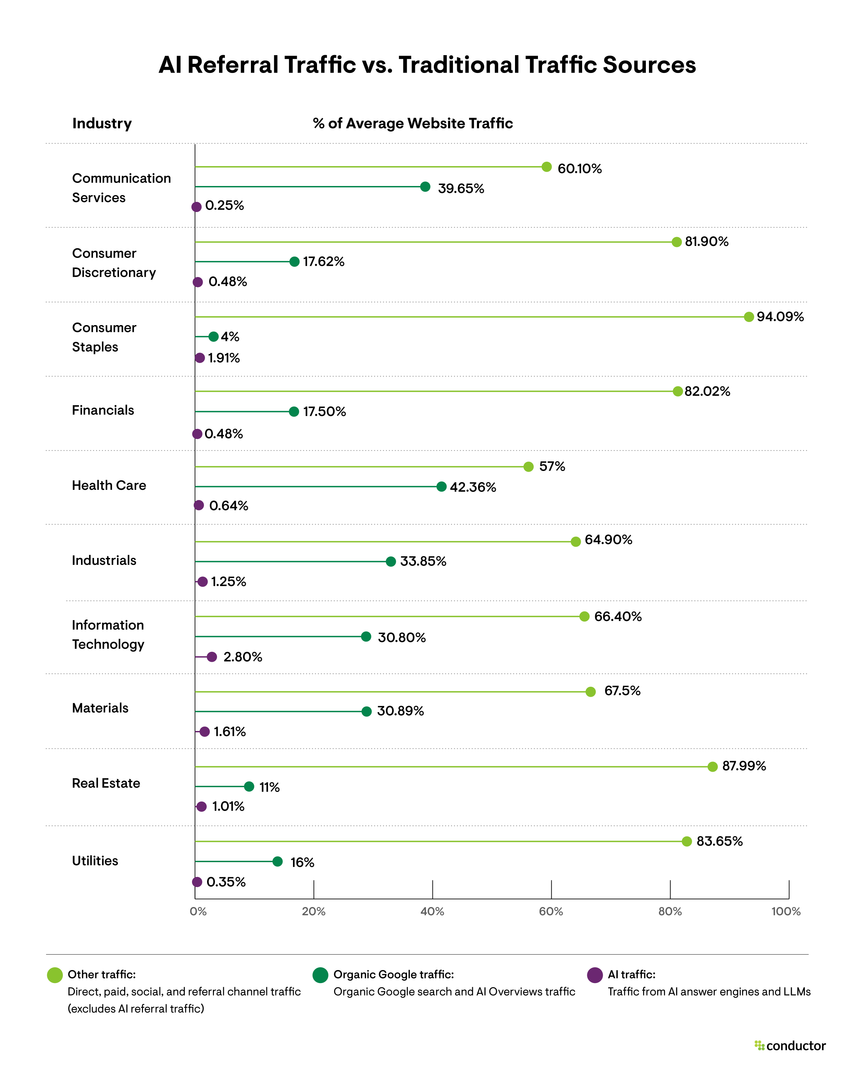
Top insights:
- Established channels like organic search, paid, direct, social, and any other referral traffic aside from AI still drive the vast majority of website visits across all industries.
- Organic search traffic remains a key traffic pillar, particularly in sectors like Health Care (42.4%), Communication Services (39.6%), and Industrials (33.8%).
This data underscores the continued importance of a strong traditional SEO strategy. Even with the rise of AI search, optimizing for visibility in the traditional Google search experience, including AI-generated result types like AI Overviews, remains essential for improving brand visibility and relevance.
If you're looking at this and saying to yourself, ‘I can't believe it,’ then you're in the wrong profession and/or you're in the wrong subreddit, listening to the wrong people.
Organic search will continue to be a cornerstone of most digital campaigns for the foreseeable future, but, as it always has, it will change, and you will need to be flexible and adapt your strategy as the landscape morphs around you.
This overlap and the high share of organic traffic across a majority of industries reinforce the need for a dual approach of traditional SEO and AEO / GEO strategies.
AI referral traffic by answer engine source: Overall industries
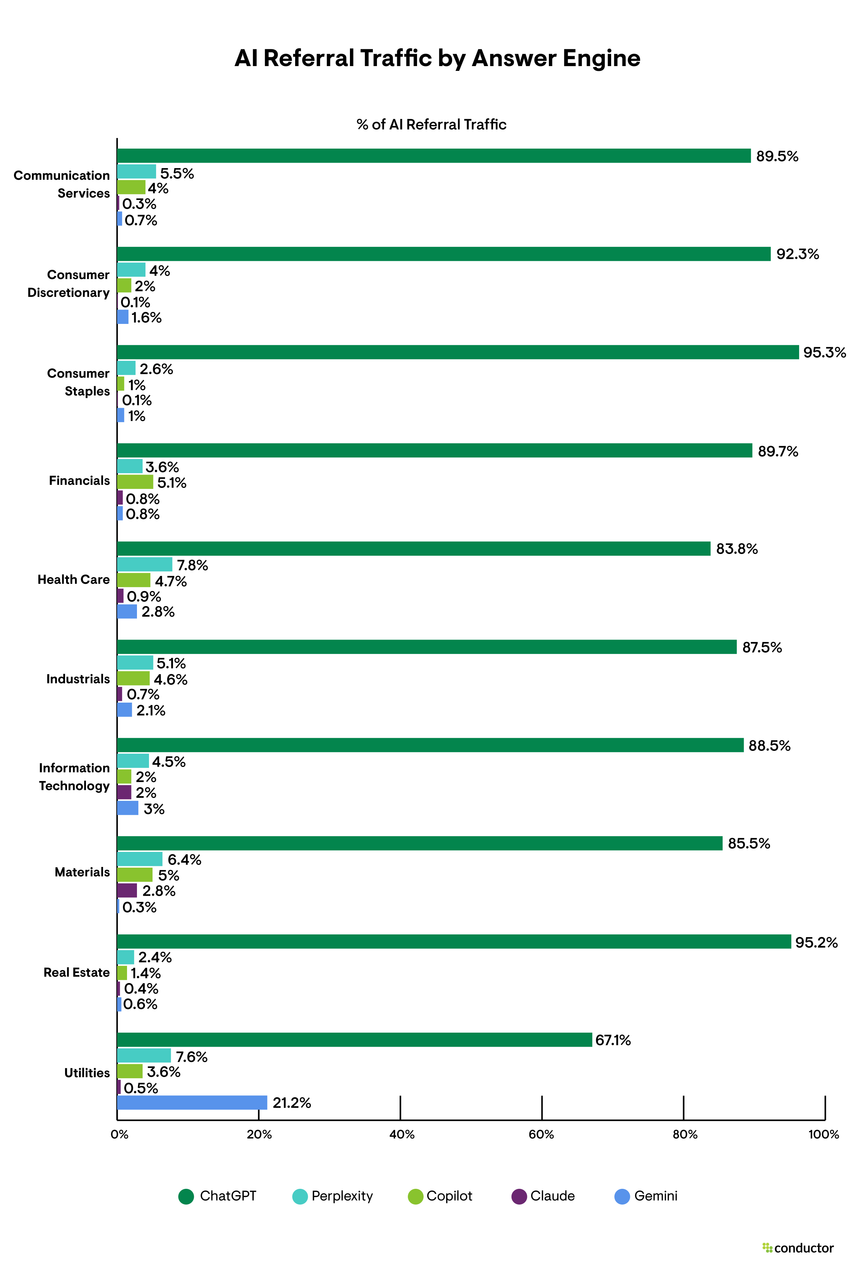
Top insights:
- On average, 87.4% of all AI referral traffic across these 10 key industries comes from ChatGPT.
- Interestingly, Gemini drove a significantly high share of AI traffic (21%) to the Utilities industry.
- This highlights why focusing on brand performance on ChatGPT alone isn’t enough. Some industries are seeing other AI engine traffic sources gain significant market share.
The key takeaway from our analysis of AI referral traffic by answer engines is that ChatGPT dominates the landscape right now. That said, ChatGPT may dominate AI referrals today, but the ecosystem is evolving fast. Winning brands won’t chase engines—they’ll future-proof their presence across every generative surface.
ChatGPT is the Google of AI search, so this data should not be surprising to anyone. This also proves that history repeats itself and that you don't need a separate strategy for each individual LLM.
Instead, it’s like back in the day with Google vs. Bing, you need a holistic approach to your brand's visibility that will benefit you across all LLMs and traditional search engines.
Brands looking to future-proof AI search visibility should invest in an enterprise AEO platform that measures performance across a majority of answer engines and provides intelligent optimization recommendations.
Check out our list of top AEO / GEO tools in 2025 so you can choose the one that fits your workflow and start building visibility that actually drives results.
Perplexity accounted for the next highest referral traffic share overall, although there were some differences on an industry-specific basis. Specifically, Gemini and Copilot drove a larger percentage of traffic in certain sectors. For example, Gemini drove 21% of AI traffic to the Utilities industry, while Copilot accounted for 5% of traffic in the Financials industry, which was the second highest behind ChatGPT.
Perplexity is the Bing of AI search. Pay attention and optimize for trends and insights around ChatGPT, and it will trickle down to all of the other ‘major’ LLMs.
AEO / GEO market share leaders by industry
This section is an analysis of the brands and domains that won the most market share based on the highest number of AI citations and brand mentions across our analysis of 17M AI-generated responses and 100M citations between May and September 2025. These results reflect the brands that had the highest AI visibility by industry during that time period.
Get a look at the top market share leaders by subindustry to get a more granular view of leaders in our industry-specific benchmarks reports:
- Communication Services
- Consumer Discretionary
- Consumer Staples
- Financials
- Health Care
- Industrials
- Information Technology
- Real Estate
Communication Services AI market share leaders

Communications Services industry: Top 5 domains by AI citation market share
- youtube.com
- reddit.com
- google.com
- investopedia.com
- reuters.com
The dominance of youtube.com highlights the high value AI models place on video content, frequently citing it as an authoritative source for visual how-to guides, explainers, and news clips.
It’s important to note that while youtube.com is the domain that’s ranking, the video content itself comes from a wealth of different brands; YouTube is just the domain that gets the credit. So, it’s a great visibility play to ensure brand videos hosted on YouTube are optimized for AI and traditional search to take advantage of the channel’s leading market share.
Video content holding a prominent position in AI search should not be a surprise to anyone. One of the best ways to share your brand expertise is through video content. Host your content on YouTube and then embed it across multiple platforms.
Reddit.com's strong showing signals that AI models are sourcing real-world, anecdotal answers from forums to provide insights on authentic user experiences and troubleshooting advice. Responses based on Reddit replies are often more direct and specific than the content found on traditional corporate websites.
Communications Services industry: Top 5 brand leaders by AI brand mention market share
- YouTube
- Investopedia
- Roku
- Forbes
This data reinforces the authority of Google, YouTube, and Investopedia, showing that they are mentioned by name, not just cited. Interestingly, Roku has become a significant part of the AI conversation around streaming platforms and hardware.
Consumer Discretionary AI market share leaders
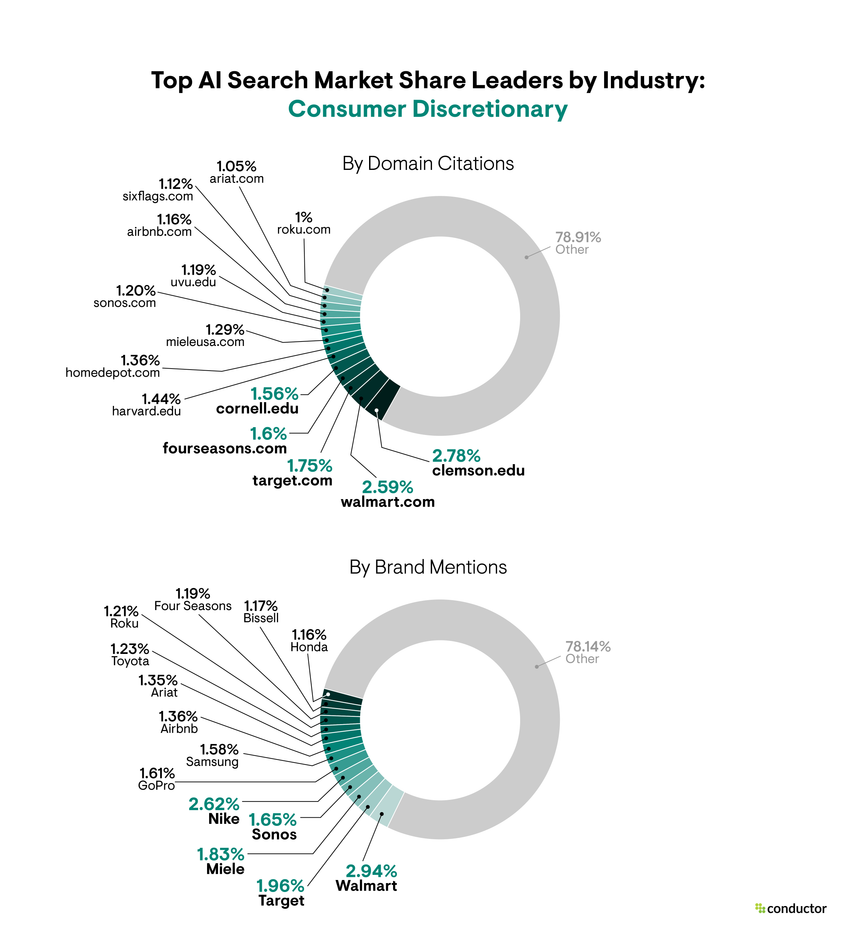
Consumer Discretionary industry: Top 5 domains by AI citation market share
- clemson.edu
- walmart.com
- target.com
- fourseasons.com
- cornell.edu
Clemson.edu earned the highest market share of all cited domain leaders for the industry, with nearly double the market share compared to the next two higher education domain leaders (cornell.edu and harvard.edu). Clemson’s strong showing was in part driven by a new AI visibility-focused content strategy, involving AI-powered topic research, strategic content prioritization, AI-assisted content creation, and more. These efforts resulted in Clemson capturing 91% AIO market share, along with increased AI citations and brand mentions in answer engines, which they achieved by leveraging Conductor.
The presence of major retailers, such as Walmart.com and Target.com, is expected, as they are cited for a massive range of product information and availability. They’re also widely recognized and authoritative domains that AI will be more likely to cite than lesser-known sites.
Consumer Discretionary industry: Top 5 brand leaders by AI brand mention market share
- Walmart
- Target
- Miele
- Sonos
- Nike
Walmart and Target again lead the way in market share of brand mentions. The other three brands—Miele (premium appliances), Sonos (premium electronics), and Nike (apparel)—demonstrate that AI is also fielding highly specific, branded queries.
Consumer Staples AI market share leaders
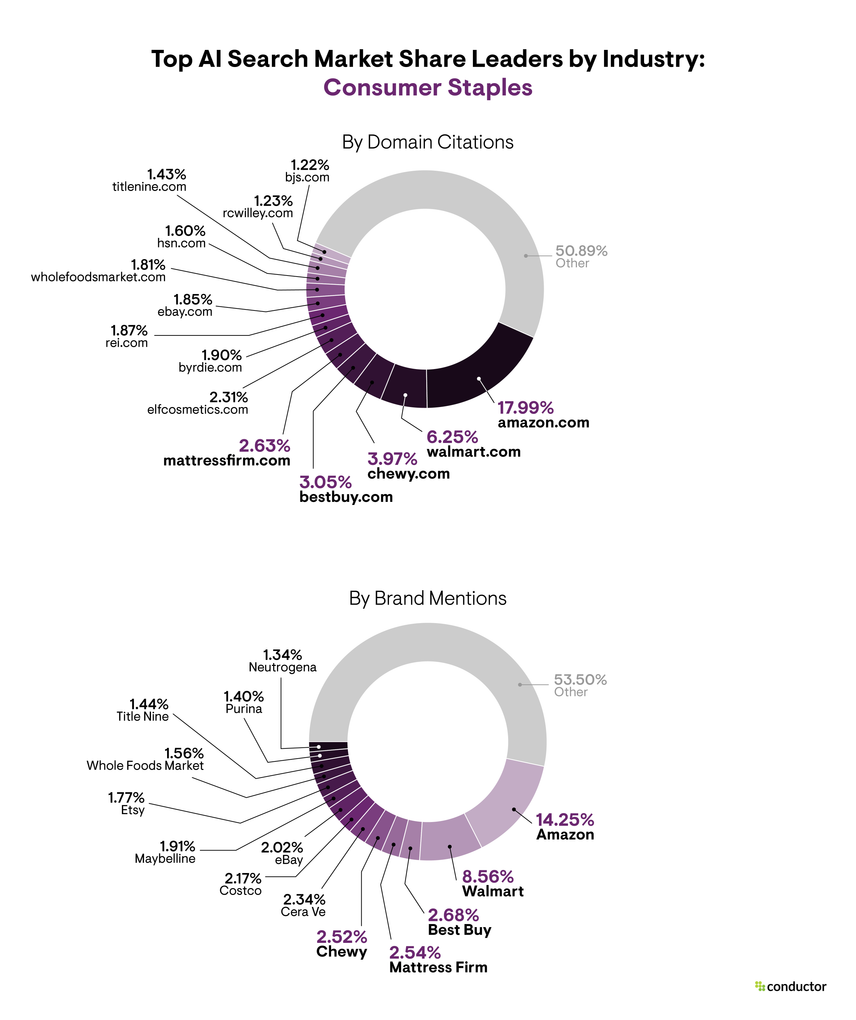
Consumer Staples industry: Top 5 domains by AI citation market share
- amazon.com
- walmart.com
- chewy.com
- bestbuy.com
- mattressfirm.com
This list reflects the dominance of retail giants like amazon.com and walmart.com. This is due to the fact that Amazon and Walmart are authoritative retail sites that are well known for selling a very wide range of products. So it makes sense that LLMs would cite them as the ultimate authorities for the vast majority of consumer staples queries related to product information, availability, and comparisons.
Consumer Staples industry: Top 5 brand leaders by AI brand mention market share
- Amazon
- Walmart
- Best Buy
- Mattress Firm
- Chewy
The brand list is almost exactly the same as the list of top-cited domains, reinforcing the market power of Amazon and Walmart. AI models mention these brands by name when users ask where to buy a product or which product is a better value, solidifying their brand authority in AI-generated answers.
Financials AI market share leaders
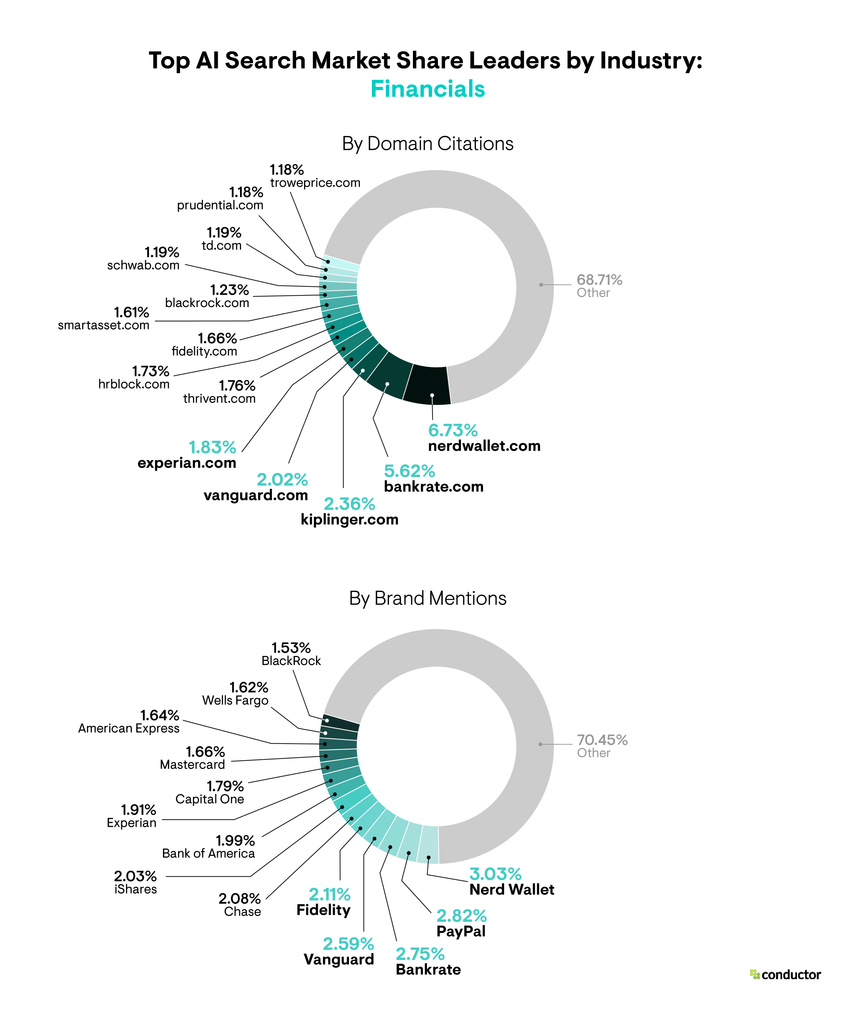
Financials industry: Top 5 domains by AI citation market share
- nerdwallet.com
- bankrate.com
- kiplinger.com
- vanguard.com
- experian.com
This list is dominated by financial publishers and comparison sites, not traditional banks. Nerdwallet.com and bankrate.com likely lead because they have massive libraries of high-quality, long-form content that directly answers complex your money or your life (YMYL) questions. AI models are often trained to prioritize these types of authoritative and educational sources when providing financial definitions and advice.
This insight is WILD because these sites have struggled in traditional search since the advent of AI, with steep declines in visibility in favor of actual financial institutions and a devaluation of what I classify as content hubs and aggregators.
I believe sites like NerdWallet and Bankrate will experience struggles as LLMs recognize and surface actual financial institutions vs. aggregator sites that lead you to said financial institution. Time will tell.
Financials industry: Top 5 brand leaders by AI brand mention market share
- Nerd Wallet
- PayPal
- Bankrate
- Vanguard
- Fidelity
Similar to the domain list, NerdWallet and Bankrate lead in brand mentions, showing their brand authority is as strong as their domain authority. The appearance of PayPal highlights its role as a key player in financial services. Vanguard and Fidelity are mentioned as top-tier investment firms, indicating that AI is fielding specific, high-intent queries about investing and retirement.
Health Care AI market share leaders
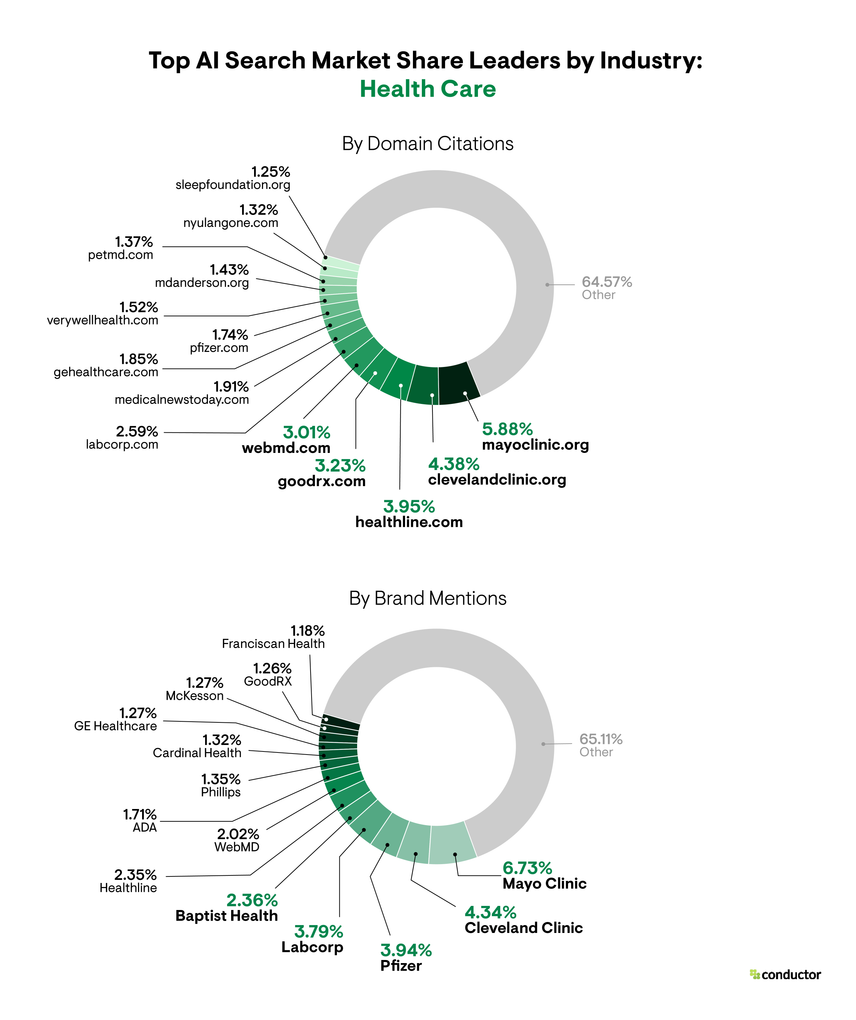
Health Care industry: Top 5 domains by AI citation market share
- mayoclinic.org
- clevelandclinic.org
- healthline.com
- goodrx.com
- webmd.com
This list is dominated by top-tier medical institutions and trusted health publishers. As another YMYL category, AI models are heavily weighted to prioritize sources with the highest level of expertise and authority. Mayoclinic.org and clevelandclinic.org likely lead because they are world-renowned hospital systems, and healthline.com and webmd.com are massive repositories of expert medical information.
Health Care industry: Top 5 brand leaders by AI brand mention market share
- Mayo Clinic
- Cleveland Clinic
- Pfizer
- Labcorp
- Baptist Health
This AEO / GEO market share leaders list reinforces the authority of Mayo Clinic and Cleveland Clinic, showing they are recognized as authoritative brands, as well as authoritative websites. Both brands are known to provide robust and comprehensive “Health Libraries,” which function as the FAQ/glossary pages that AI can easily pull authoritative and accurate answers from. That extensive library content strategy could also be why both brands continue to perform well organically, showing that a strong SEO strategy helps deliver AI search success as well.
Industrials AI market share leaders

Industrials industry: Top 5 domains by AI citation market share
- deloitte.com
- indeed.com
- mckinsey.com
- wolterskluwer.com
- siemens.com
This list is dominated by major professional services and consulting firms. Deloitte.com and mckinsey.com lead because they are considered authorities for B2B queries, producing extensive thought leadership, white papers, and industry analysis that AI models rely on to answer complex questions about the commercial & professional services subindustry.
Industrials industry: Top 5 brand leaders by AI brand mention market share
- Deloitte
- Amazon Web Services
- Siemens
- ADP
- McKinsey
Deloitte's brand mention market share is even stronger than its domain citation share, cementing its position as a primary source for business insights. The high rank of Amazon Web Services (AWS) is significant, indicating that AI-driven conversations about the industrial sector are heavily focused on digital transformation, cloud computing, and data infrastructure.
Information Technology AI market share leaders

IT industry: Top 5 domains by AI citation market share
- google.com
- microsoft.com
- sap.com
- dell.com
- adobe.com
This list is dominated by the industry's tech giants. Google.com and microsoft.com lead because they are the primary, authoritative sources for a massive volume of technical documentation, "how-to" guides, and product information related to their own market-leading offerings.
IT industry: Top 5 brand leaders by AI brand mention market share
- Microsoft
- SAP
- Apple
- Adobe
The list of leaders for AEO / GEO brand mentions market share is fairly similar to the list of domain citation leaders. Google, Microsoft, SAP, and Adobe are in the top five for both categories, highlighting their brand, as well as their domain authority, within the industry.
Materials AI market share leaders

Materials industry: Top 5 domains by AI citation market share
- evonik.com
- airgas.com
- trex.com
- specialchem.com
- ingredion.com
This list is dominated by highly specialized B2B manufacturers. evonik.com (specialty chemicals) and airgas.com (industrial gases) lead because they are authoritative sources for the technical data, specifications, and application guides that AI models require to answer complex, B2B-focused queries.
Materials industry: Top 5 brand leaders by AI brand mention market share
- Trex
- 3M
- Evonik
- Airgas
- Ingredion
Trex likely leads the way for AI brand mentions due to its wide brand recognition with consumers, driving a lot of comparative and "best of" queries. 3M's strong showing could be due to the sheer amount of products it offers and its status as a household name.
Real Estate AI market share leaders
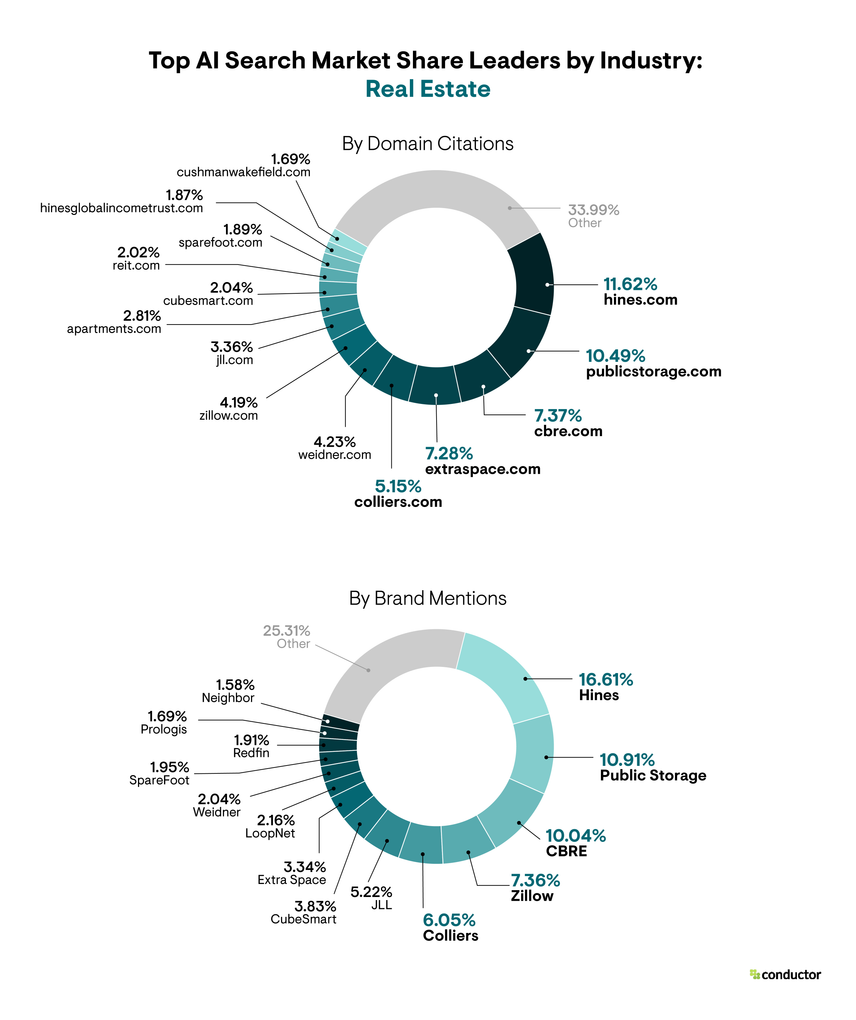
Real Estate industry: Top 5 domains by AI citation market share
- hines.com (11.62%)
- publicstorage.com (10.49%)
- cbre.com (7.37%)
- extraspace.com (7.28%)
- colliers.com (5.15%)
Hines.com and cbre.com most likely lead because they are global authorities that publish extensive, data-rich research and thought leadership on commercial properties, development, and investment that AI can cite to answer complex financial and B2B queries.
Real Estate industry: Top 5 brand leaders by AI brand mention market share
- Hines
- Public Storage
- CBRE
- Zillow
- Colliers
The brand mentions list shows Hines's authority is even stronger than its domain data, with its brand being mentioned more frequently than its domain is cited. While zillow.com didn't make the top 5 for citations, its brand is mentioned constantly, indicating that AI models recognize Zillow as the go-to brand for residential real estate and home value queries.
Utilities AI market share leaders

Utilities industry: Top 5 domains by AI citation market share
- newfortressenergy.com
- denverwater.org
- constellation.com
- energysage.com
- gevernova.com
Newfortressenergy.com and gevernova.com dominate by providing highly technical, B2B, and financial information that AI models cite for complex energy questions. denverwater.org and constellation.com are massive public utilities, cited as authorities for information on water and power.
Utilities industry: Top 5 brand leaders by AI brand mention market share
- New Fortress Energy (35.46%)
- GE Vernova (14.61%)
- Constellation (10.63%)
- Denver Water (9.92%)
- National Grid (9.07%)
New Fortress Energy's brand mention market share is massive (over 35%), which is significantly higher than its domain citation share. This indicates that AI models are not just citing their website but are actively discussing the company as a primary subject in answers related to energy infrastructure and LNG. GE Vernova's high ranking also shows strong brand recognition as a key player in the energy transition, making it a frequent topic of AI-driven conversations.
AI Overview benchmarks data
Despite the rise of AI answer engines, billions of daily searches still take place on the world’s most popular traditional search engineSearch Engine
A search engine is a website through which users can search internet content.
Learn more: Google.
But AI disruption has come for this search surface, too, as AI Overview (AIO) results—AI-generated summaries that appear at the top of some Google search results pages—are appearing for more searches every day, which means that users are getting their answers directly from AIO results rather than scrolling further to see the standard top-ranked content on page 1.
As a result, it’s essential for brands to optimize their site and content to increase their chances of winning an AIO result and getting seen where it matters most.
AIO methodology
We analyzed AI Overview data in the U.S. over a 4-week period from September 15 through October 12, 2025, to get a sense of how AI-powered search is impacting Google’s search experience. To do so, we analyzed approximately 21.9 million unique Google searches from Conductor’s traditional search index. Of those Google searches, nearly 5.5 million generated an AIO result.
Percentage of search queries that triggered AIO results by industry
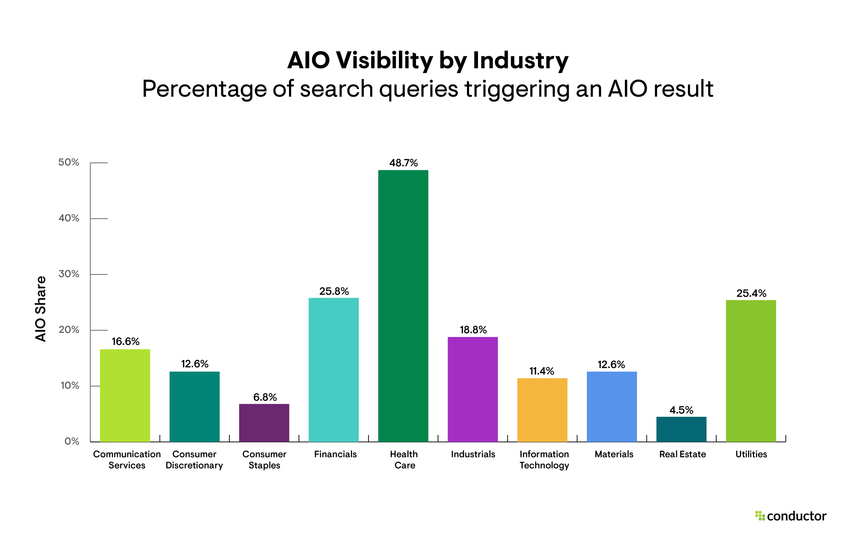
Top insights
Our analysis shows that while each industry is seeing some kind of AI Overview presence within search results, the percentage of queries generating AI Overview results varies significantly between industries.
- Of the 21.9M Google searches we analyzed, 5.5M generated an AIO result (25.11%), so just over one quarter of the analyzed Google searches trigger an AIO result.
- The industries with the highest percentage of AIO results are Health Care (48.7%), Financials (25.7%), and Utilities (25.4%).
- It seems that AIO results are being generated more often for YMYL categories and more complex queries.
- The industries with the lowest percentage of AIO results are Real Estate (4.4%) and Consumer Staples (6.8%).
- AI-generated responses aren’t being leveraged for transactional or more localized queries. That’s why we saw comparatively few AIO results in the Real Estate and Consumer Staples industries.
Which page types get cited most often in AIO results?

In our analysis, we broke down the frequency of AIO results based on page type across all 10 of the analyzed industries. Specifically, we wanted to see what types of content—blogs, videos, Wikipedia pages, product pages, etc.—were cited most often in AI Overviews.
We found that these five page types were most likely to be cited in AIO results:
- Blog content
- Video content
- Article content
- News content
- Product pages
This tracks with what we know about AI Overviews. Generally, AIO is leveraged to break down complex and informational topics into more digestible summaries. It makes sense that longer-form content like blogs, articles, and videos would be summarized in an AI overview.
While this isn’t a groundbreaking insight, it’s data-driven confirmation that you need to continue to create high-quality content in these areas, and it will help you show up more in AI search, just like it helps you show up in traditional search.
You don't need to reinvent the wheel, you need to make the wheel bigger—by creating more content in more places—and faster—by creating agility in your organization.
Check out our industry-specific benchmarks reports to see which brands had the largest share of voice in AIO results:
- Communication Services
- Consumer Discretionary
- Consumer Staples
- Financials
- Health Care
- Industrials
- Information Technology
- Real Estate
Summary
The future of digital discovery belongs to the brands that understand that AI visibility isn’t a nice-to-have metric—it’s the next frontier of search performance.
Having informed, data-driven KPIs for both SEO and AEO enables digital teams to measure their total search visibility and adapt their strategies to expand beyond clicks and rankings to account for zero-click citations and mentions as well. Leverage the industry benchmarks featured here to understand how your brand performs and where there are opportunities to improve to ensure you show up at every stage of the modern customer journey.
Remember, user adoption of AI search is accelerating, and more customer decision-making is happening in these answer engines. While AI referral traffic is a small (but high-intent) channel today, now is the time to secure your market share in these new, answer-driven results to ensure you show up everywhere your audience is searching.

![Patrick Reinhart, VP, Services and Thought Leadership, [object Object]](https://cdn.sanity.io/images/tkl0o0xu/production/9bc72298b24ad01b732de4c3376f79546d20f81c-3542x3542.png?fit=min&w=100&h=100&dpr=1&q=95)
![Seth Besmertnik, CEO and Co-Founder, [object Object]](https://cdn.sanity.io/images/tkl0o0xu/production/79e6eda2a43959d9ac71253ccff188677b8260d8-3542x3542.png?fit=min&w=100&h=100&dpr=1&q=95)
![Andrew Bolton, SVP, Chief Customer Officer, [object Object]](https://cdn.sanity.io/images/tkl0o0xu/production/0955603fd1d53523fe6b174b851cc9e0323f2875-800x800.jpg?fit=min&w=100&h=100&dpr=1&q=95)


